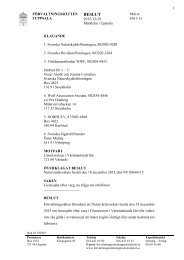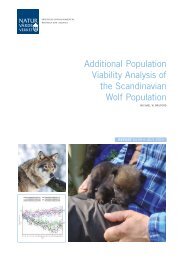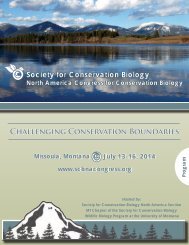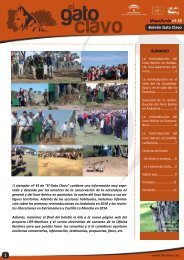1oC3Dbk
1oC3Dbk
1oC3Dbk
You also want an ePaper? Increase the reach of your titles
YUMPU automatically turns print PDFs into web optimized ePapers that Google loves.
Crane. Among other actions, we are assisting with the<br />
development of a water management and monitoring plan for<br />
the nine sub lakes within Poyang Lake National Nature Reserve.<br />
We co-organized the workshop ‘Cranes and Sustainable<br />
Agriculture’. The workshop, with over 100 participants, issued<br />
A Call to Action sent to governments of Northeast Asia. A side<br />
event launched a global network aimed at reducing impacts of<br />
power lines upon cranes.<br />
The Crane SG is now working on a practical handbook for<br />
reducing conflicts between cranes and agriculture.<br />
A website has been established including the posting of<br />
Global Crane News.<br />
Mr Jim Harris<br />
Chair, Crane Specialist Group<br />
Crocodile Specialist Group<br />
The mission of the Crocodile Specialist Group (CSG) is to<br />
assist IUCN and SSC to meet their missions with regard to the<br />
conservation, management and sustainable use of world<br />
crocodilians. The CSG has 496 members throughout 62<br />
countries and conducts global working meetings biennially.<br />
Red List assessments were completed for Crocodylus<br />
siamensis, Tomistoma schlegelii, C. mindorensis and<br />
C. plaustris. Of the 23 species of living crocodilians, the Red<br />
List assessments now categorize the global populations of six<br />
species as Critically Endangered, one as Endangered and<br />
three as Vulnerable.<br />
CSG members have been intimately involved in successful<br />
reintroductions of two species listed as Critically Endangered<br />
on The IUCN Red List; Alligator sinensis in China and<br />
Crocodylus mindorensis in the Philippines. Various proposals<br />
are being considered to embark on reintroduction programs<br />
for another species listed as Critically Endangered; Crocodylus<br />
siamensis in both Thailand and Cambodia.<br />
Management programs for the 23 species of crocodilians,<br />
across some 100 countries, are highly diverse. All species are<br />
listed on the Appendices of CITES, with 12 species involved in<br />
regulated international trade, producing either “classic”<br />
(A. mississippiensis, Crocodylus acutus, C. moreletii,<br />
C. niloticus, C. novaeguineae, C. porosus and C. siamensis),<br />
or caiman (Caiman crocodilus, C. yacare, C. latirostris,<br />
Melanosuchus niger) skins. The conservation management<br />
programs for these commercially valuable species are highly<br />
Saltwater Crocodile. © Grahame Webb<br />
diverse. Production is through captive breeding, ranching<br />
(eggs or juveniles), wild harvest, or various combinations of<br />
these. The CSG is committed to fostering protection strategies<br />
where they are the ones most needed within a national<br />
context, and sustainable use strategies where incentives are<br />
required to tolerate crocodilians. A key CSG aspiration in<br />
countries which trade in crocodilians is that trade is legal,<br />
sustainable and verifiable.<br />
Through supporting sustainable use programs, the CSG<br />
contributes to economic development within countries<br />
managing their crocodilian populations for this purpose. The<br />
CSG also assists by making small grants available to graduate<br />
students working on crocodilians for their research projects<br />
anywhere in the world. In 2013, a further 13 students were<br />
granted CSG Student Research Assistance Scheme grants,<br />
which makes a total of 65 recipients from 22 countries, since<br />
the scheme was initiated in 2009.<br />
Virtually all donations in cash and in-kind received by the<br />
CSG come from or through its members. These donations are<br />
made to an NGO (International Association of Crocodile<br />
Specialists Inc.), whose mission is to support the IUCN SSC<br />
Crocodile Specialist Group.<br />
Prof. Grahame Webb<br />
Chair, Crocodile Specialist Group<br />
Crop Wild Relative Specialist Group<br />
Our mission is to help ensure that crop wild relatives are<br />
adequately conserved and sustainably utilized, to enhance<br />
global food security and aid poverty alleviation. The key<br />
objectives of our Specialist Group are to develop effective<br />
strategies for gathering, documenting and disseminating<br />
baseline information on crop wild relatives (CWR); promote<br />
the conservation and use of CWR; provide advice, expertise<br />
and access to appropriate contacts to enhance the actions<br />
of individuals or organizations working on CWR conservation<br />
and use, and increase awareness of the importance of<br />
CWR diversity to agriculture and the environment among<br />
governments, institutions, decision-makers and the general<br />
public.<br />
At the request of the FAO Commission on Genetic<br />
Resources for Food and Agriculture, the group prepared an<br />
Lepidium turczaninowii Lipsky is a wild relative of cabbage crops and garden<br />
cress. Assessed as Critically Endangered on The IUCN Red List, it is<br />
endemic to the surroundings of Feodosija in eastern Crimea and has<br />
recently only been found in Ilyi Capes. © Victor Melnik<br />
48 IUCN species Annual Report 2013






